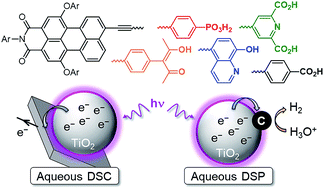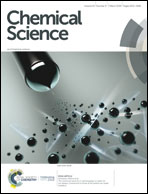Solar electricity and fuel production with perylene monoimide dye-sensitised TiO2 in water†
Abstract
Dye-sensitisation of TiO2 and other metal oxides is an established strategy to couple solar light harvesting with efficient charge separation for the production of electricity in dye-sensitised solar cells (DSCs) or fuels in dye-sensitised semiconductor photocatalysis (DSP). Perylene monoimide (PMI) dyes have emerged as promising organic dyes, but they have not previously been used in a functional assembly with TiO2 in aqueous solution. Here, five novel PMI dyes bearing carboxylic acid, phosphonic acid, acetylacetone, hydroxyquinoline or dipicolinic acid anchoring groups for attachment onto TiO2 are reported. We identified functional DSC and DSP systems with PMI-sensitised TiO2 in aqueous solution, which permitted a side-by-side comparison with respect to performance between the two systems. Structure–activity relationships allowed us to suggest anchor-condition-system associations to suit specific anchoring groups at various pH values, and with different electron mediators (redox couple or sacrificial electron donor) and catalysts in DSC and DSP schemes. A DSC sensitised with the hydroxyquinoline-modified PMI dye reached the highest short-circuit current density (JSC ≈ 1.4 mA cm−2) in aqueous electrolyte solution during irradiation with simulated solar light. This dye also achieved a turnover number (TONPMI) of approximately 4900 for sacrificial proton reduction after 24 h irradiation in a DSP scheme with Pt as a H2-evolving co-catalyst at pH 4.5. This performance was only surpassed by the carboxylic acid-bearing dye, which reached a new benchmark turnover number (TONPMI ≈ 1.1 × 104 after 72 h) for an organic dye in nanoparticulate DSP for solar fuel production. At higher pH (8.5), our results showed that the phosphonic acid group allows for higher performance due to a stronger anchoring ability. This study provides a platform for aqueous PMI dye-sensitised TiO2 chemistry and gives valuable insights into the performance of different anchoring groups in DSC and DSP systems.

- This article is part of the themed collection: Most popular 2018-2019 energy articles


 Please wait while we load your content...
Please wait while we load your content...